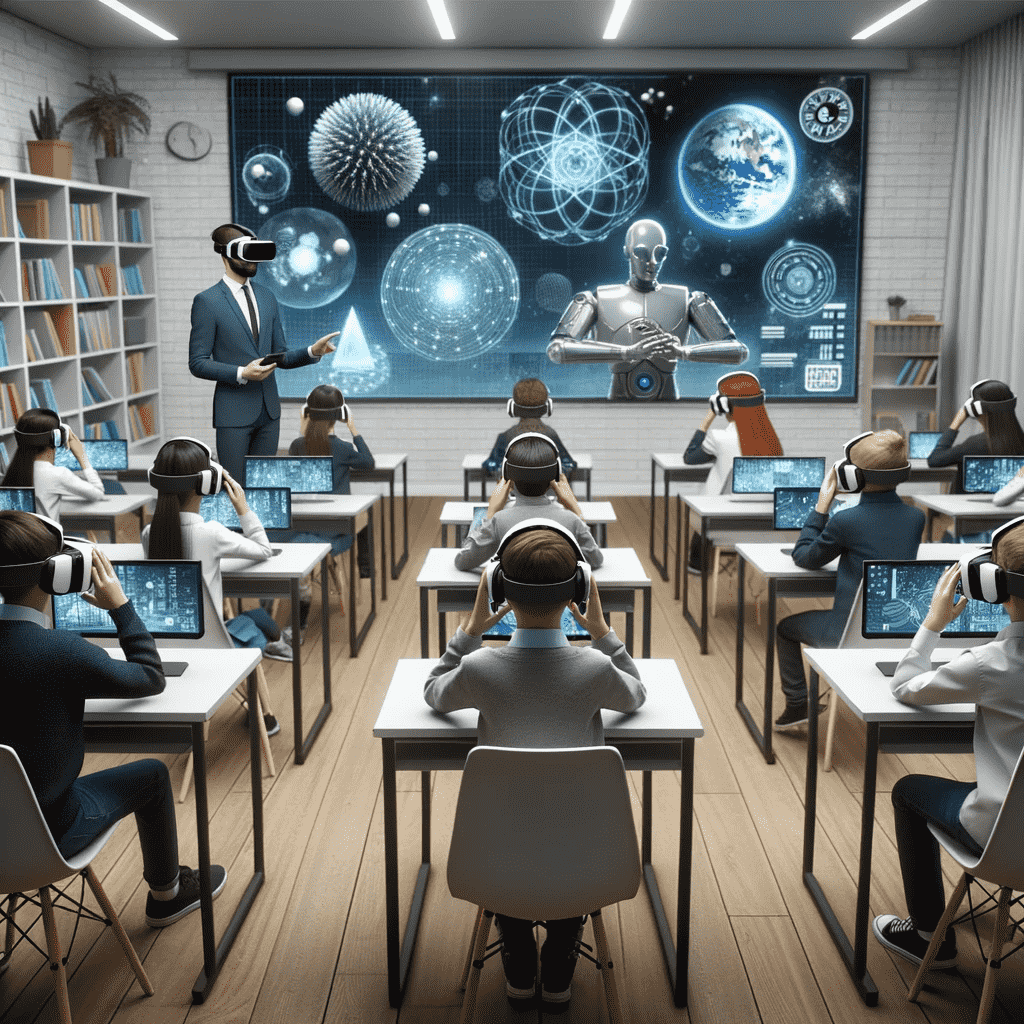
The Virtual Reality Classroom: A New Horizon in Immersive Learning Experiences
Introduction:
In the progressively digital era, "Virtual Reality" (VR) classrooms emerge as a pivotal turning point in the educational domain, weaving a tapestry where technology and education converge to forge enhanced, immersive learning experiences. The “VR Classroom” extends beyond the conventional teaching paradigms, providing a dynamic, engaging, and inclusive educational environment.
“For decades, immersive environments have been heralded as a forthcoming revolution in education,” observes Dr. Michelle D. Miller, a prominent scholar in psychology and education. The underlying purpose of this research is to peel back the layers, exploring the depth and breadth of VR classrooms, and gauging their impact, applications, and future in the education system.
1: Understanding VR Classrooms: An Augmented Reality in Learning
Defining the Concept
Virtual reality classrooms embody a digital, interactive, and 3D learning environment, where educational content is not merely presented but experienced. By leveraging VR, the learning environment becomes an immersive entity, wherein students navigate, interact, and learn through experiences, catapulting the traditional learning models into a virtual, augmented, and far more engaging dimension.
Evolutionary Trace
- Phase 1: Introductory Period - Utilizing basic VR for simplistic virtual field trips.
- Phase 2: Integration - Introducing VR labs, simulations, and interactive lessons.
- Phase 3: Immersion - Full-fledged VR classrooms providing holistic, immersive learning experiences.
Key Components
- The VR Tech Stack: Comprising headsets, sensors, and adaptive software.
- Immersive Content: Including virtual labs, simulations, and interactive lessons.
- Interactive Platforms: Enabling communication, collaboration, and co-existence in a virtual space.
2: Impact Analysis: VR and Its Educational Outcomes
Enhancing Student Engagement
In a case study conducted in a suburban school in the United States, VR applications were found to enhance student engagement levels by approximately 23%, predominantly due to interactive and immersive learning sessions.
Example: Engaging students in a VR journey through human anatomy, exploring bodily systems interactively, which is otherwise theoretical and textbook-bound.
Improving Learning Outcomes
A research endeavor at Stanford University revealed that students participating in VR-enhanced learning sessions showcased a notable improvement of about 19% in recall and application of concepts compared to their counterparts engaging in traditional learning methodologies.
Inclusion and Accessibility
“VR classrooms have the potential to create equal learning opportunities for students globally,” asserts Dr. John T. Thompson, an advocate for inclusive learning technologies.
- Supporting Instance: Implementing VR in schools for specially-abled children, tailoring experiences that cater to their specific learning needs.
3: Technological Advancements: The Tools Carving the VR Educational Niche
Exploring the Tools
- VR Headsets: Facilitating the immersive visual experience.
- Haptic Devices: Enabling tactile interactions within the VR realm.
- Adaptive Learning Management Systems: Managing, adapting, and delivering content seamlessly.
Developers at the Forefront
A notable application is "ClassVR," a platform offering a comprehensive VR teaching and learning tool, aimed at delivering inclusive, immersive, and engaging VR experiences, thereby underscoring the advancements in VR educational technology.
4: Real-World Applications and Case Studies
Global Endeavors in VR Classrooms
Case Study 1: VR Integration in Higher Education – A Singapore Experience
In a pioneering effort, a Singapore-based university embarked on a journey integrating VR into their curriculum, providing students with interactive modules, thereby amplifying their engagement and learning experience, a move that witnessed a 28% enhancement in student participative learning.
Case Study 2: Enhancing Medical Education through VR - A UK Perspective
Medical students at a prestigious UK university were submerged into VR-enhanced sessions, providing them with intricate insights into surgical procedures, offering a safe, controlled, and risk-free learning environment to understand and assimilate surgical intricacies.
5: Tackling Challenges and Implementing VR Solutions in Classrooms
Despite its potential, implementing VR in classrooms is mired with challenges like:
- Financial Constraints: High costs of VR headsets and software.
- Technological Disparities: Ensuring uniform access to VR technology for all students.
- Curriculum Integration: Seamlessly integrating VR without disrupting existing curricula.
Overcoming Barriers
- Adopting a Phased Approach: Gradual integration to balance financial outflows.
- Creating a Standardized Technological Framework: To address disparities and enhance accessibility.
- Collaborative Curriculum Development: Engaging educators and technologists to synchronize VR with existing curricula.
6: Gazing into the Future: Prospects of VR and Immersive Learning
“The potential of VR in classrooms extends beyond immersive learning, opening avenues for global collaborative education,” shares Dr. Elina Hill, a tech-driven educational strategist.
Future Prospects
- Global VR Classrooms: Connecting students and educators worldwide.
- Enhanced Learning Modalities: Incorporating AR and mixed reality for a richer learning experience.
- Personalized Educational Experiences: Adaptive VR learning pathways tailored to individual needs.
Conclusion:
In enveloping, the trajectory of VR classrooms heralds an era wherein immersive, engaging, and inclusive learning is not a distant dream but an accessible reality. The amalgamation of educational content with VR technology not only augments learning experiences but also catalyzes the evolution of global, collaborative, and adaptive educational ecosystems.
However, the road ahead invites educators, technologists, policymakers, and learners to collaboratively explore, innovate, and navigate through the challenges, thereby ensuring that VR classrooms are not mere isolated phenomena but integrated, universal educational realms.
Education Future Education




